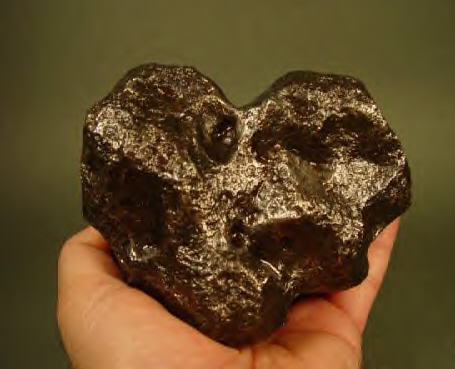Meteorites are thought to originate from
the disintegration of one or more planets similar to the Earth
in composition but smaller, perhaps in the form of a small asteroid.
A few meteorites may have even originated on the Moon or Mars.
There are three types of meteorites: irons,
stony irons, and stones.
Tektites are glassy meteorites which are
in fourth class. Tektites are fundamentally different from the
three main types.
The iron meteorite in the images is a
Campo del Cielo meteorite. Campo del Cielo means "field
of the heaven."
The weight of this specimen is 7.6 lbm.
It is an iron alloy with some nickel, cobalt and other elements.
The black crust on the meteorite in the
images is iron oxide. Many iron meteorites have a layer of rust.
The small indentations are referred to
as "thumb prints." They are caused by melting during
entry into the Earth's atmosphere.
Iron meteorites are composed of two mineral
alloys, kamacite and taenite.
Kamacite is an alloy consisting of iron
with 5% to 7% nickel. Taenite is an alloy consisting of iron
with 13% or more nickel.
Meteorites may be sliced to show the internal
cross-section. The cross-section can be polished and etched with
dilute acid. This process usually reveals bands of kamacite and
taenite. Iron meteorites are further classified depending on
the width of these bands and the angle at which they meet. Two
subclasses are octahedrites and hexahedrites.
Campo del Cielo meteorites are described
as a polycrystalline coarse octahedrite, Group I. These meteorites came from a "strewn field"
that was first discovered in 1576 by Spanish explorers in Chaco,
Argentina.
Scientists have found numerous pits and
impact craters in this area. The impact occurred between 3950
and 5800 years ago, based on dating of charred wood found in
the craters. Scientists speculate that these meteorites were
part of a single meteorite that broke up upon entering the Earth's
atmosphere.
A Spanish governor learned of the iron
from the Indians who reportedly believed that it had fallen from
heaven. The governor sent an expedition under the command of
one Captain de Miraval who brought back a few pieces of a huge
iron mass he called Meson de Fierro, which means "large
table of iron."
|

